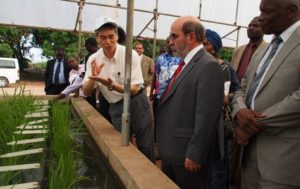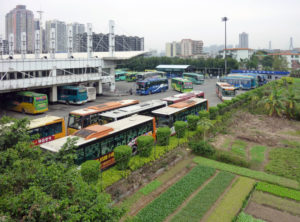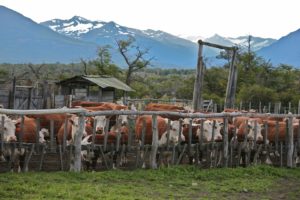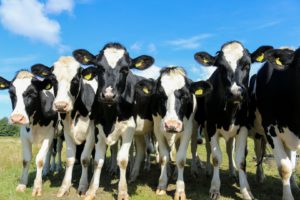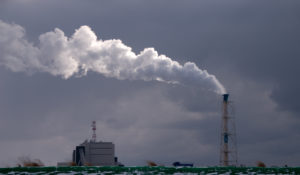Time is fast running out to transform the way we produce and consume food if we are to safeguard our health and the environment, according to Tim Benton, distinguished visiting fellow at policy research institute Chatham House.
With 12 years remaining to act to avoid catastrophic climate change, the UN body responsible for the food and agriculture sectors, which contribute up to a third of global greenhouse emissions, meets in Rome to appoint a new director general tasked with steering global food policy.
The week-long conference begins on Saturday and comes as two divergent visions – big, industrial agriculture and small, local production and consumption – clash.
“The world’s food systems are at a crossroads,” Benton said, adding that without drastic changes to the current system based on mass producing grains for starchy, high-calorie but cheap foods, we will continue to destroy the planet and to destroy people.
1945
the year the FAO was established as part of the post-war architecture for international cooperation
The UN’s Food and Agriculture Organisation (FAO), which today comprises 192 countries, was established by 42 member states in Quebec in 1945 to ensure “humanity’s freedom from hunger”, according to its constitution.
Today, mitigating the climate impacts of food production and adapting systems to unpredictable climatic conditions are mainstays of the organisation’s work.
Candidates set the tone
The FAO sets the tone for the global debate around food. Departing chief, Brazilian José Graziano da Silva, put nutrition and sustainability at the heart of the vision and it is crucial that his successor follows suit, Benton said.
The frontrunners to lead the FAO for an initial four-year term are potato expert and Chinese former vice minister of agriculture Qu Dongyu, and Catherine Geslain-Lanéelle of France.
The trade war involves everyone and has dangerous mid-term economic consequences
Geslain is also a food safety expert and former public official. She could break with EU policies banning genetically modified crops and harmful agrochemicals.
Georgian Davit Kirvalidze, a former agriculture minister is the only other remaining candidate.
Each UN member country can cast one vote for the directorship.
Economic protectionism and the US-China trade war provide a challenging backdrop for food security-oriented multilateral organisations such as the FAO, according to Roberto Rodrigues, coordinator of the centre for agribusiness studies at Brazil’s Getulio Vargas Foundation.
“The trade war involves everyone and has dangerous mid-term economic consequences,” he said.
Politics & policies
Qu started his political career in earnest in 2011 on becoming vice chairman of the Ningxia Hui Autonomous region in north-central China.
He has a doctorate in genetics and breeding from Wageningen University in Holland and experience managing a poverty-alleviation programme that tackled poison in potatoes in Guizhou, China’s poorest province.
He reportedly has the backing of a number of Latin American countries, most notably Brazil, to whom China has increasingly turned for agricultural products amid trade tensions with the US.
Rodrigues said this could be due to Brazil and China’s closer cooperation on trade in recent years and the fact they have “complementary” economies.
According to Benton, China has successfully garnered support for Qu’s candidacy in the developing world through widespread investment under the Belt and Road Initiative.
Benton said Qu is more wary of the US vision of big agriculture and biotechnological innovation to increase crop productivity than Geslaine, who appears more supportive.
Yolanda Trápaga, an agricultural economist from the National Autonomous University of Mexico (UNAM), said the big agriculture model espoused by the US is fundamentally flawed from both an environmental and economic perspective.
It’s like investing in a mattress factory with no roof: when it rains you lose everything
Nature has limits and our search for cheap food is decimating soils and the biodiversity of our oceans, where the problem is even more serious than on land, she said.
Yet agriculture, which depends on healthy soil and a reliable water cycle, is treated as any other branch of the economy.
“Industrial production is the biggest con in terms of energy and how nature functions,” Trápaga said. She pointed to the necessary inputs that include fertilizers and petrol-powered machinery that can render less energy from grains than they put in.
Nor can international capital handle the high risks of investing in agriculture since crops – and profits – depend on unpredictable weather patterns, she said.
“It’s like investing in a mattress factory with no roof: when it rains you lose everything.”
Family-run farms, which account for around 70% of the world’s food, often assume the burden. Subsidies and quotas for these and fishing companies enable them to survive, Trápaga said.
70%
of the world's food is produced by family run farms
Rodrigues, who was Brazil’s agriculture minister from 2003-6, acknowledged the high risks of agricultural activity and criticised subsidies that he said distort the market.
“When rich countries interfere in trade and prices, producers in developing countries that don’t have subsidies lose market share,” he told Diálogo Chino.
Instead, Rodrigues favours rural insurance schemes that protect producers against climate-related losses. He said rather than agricultural policies, these are more like food security policies for urban populations.
The US, Canada and Argentina are among the countries that achieve grain self-sufficiency of up to 120%, according to the FAO. These generate surpluses that are often wasted but which enable producers to absorb financial losses.
The industrial production method espoused by these countries creates “a vicious cycle” for the climate, Benton said.
Few, easily transportable crops are cultivated, which drives down costs for consumers. These grains are also fed to methane-emitting livestock, the rearing of which drives deforestation, accelerating climate change, and in turn impacting yields and “nutrition density”.
From industrial to small-scale food systems
The result of industrial food production is a perverse scenario in which 820 million people lack access to basic food and over 2 billion are obese because of a diet based on processed grains and added sugar.
This was one of the main findings of the recent EAT-Lancet Report on health, diets and sustainable food systems, which recommended that we more than double our current consumption of nuts, fruits, vegetables and legumes.
Benton said multilateral efforts to combat hunger have historically focused on calorie intake rather than nutrition.
Trápaga warned against modern monoculture farming and crop specialisation, saying that pre-Colombian civilisations enjoyed a diverse menu that satisfied their needs.
She highlighted the traditional Mesoamerican farming method Milpa, which cultivates a number of foods in one place. Various crops cover the planted area, eliminating channels that allow wind to erode the soil and pests to spread.
“You have lower yield than in a specialised system but the payoff is positive,” Trápaga said. “You create a natural barrier and protect against pests. If they attack corn they just keep going, but if they come across a different crop they stop.”
Nor is there a need for chemical fertilisers since crops such as beans and chickpeas naturally replenish the soil with nutrients such as nitrogen.
It’s a make or break decade
Alejandro Guarin, a researcher on informal food systems at the International Institute for Environment and Development (IIED), said the FAO meeting presents an opportunity to focus on supporting local, small-scale production that relies on family, mostly women’s, labour and which provides more benefits to the poor.
It is a system the FAO has ignored for too long, he said.
“It needs to work directly with those who work in, and benefit from, the food system of the poor. It must recognise them as allies in the development of a fairer, more sustainable food system.”
Rodrigues agrees that we need more nutritious, healthy food but said that in a globalised economy, local production only makes sense if it’s cheaper than what other countries might be capable of producing sustainably.
With the option of running for two consecutive terms, the next FAO head could oversee the organisation up until 2030, the deadline for achieving the UN’s Sustainable Development Goals.
“It’s a make or break decade,” Benton said.
